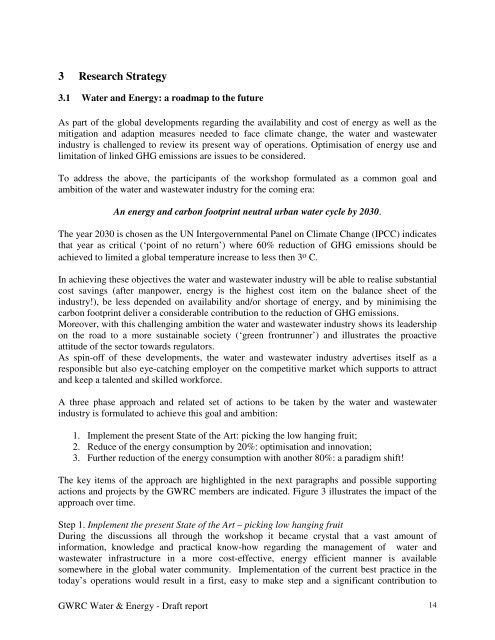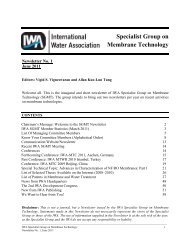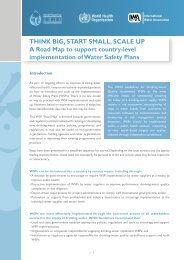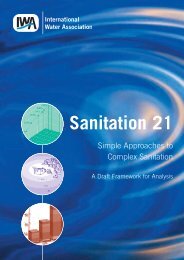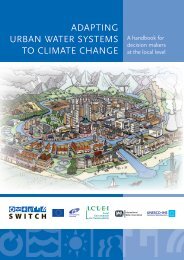Water and Energy - Draft Report of the GWRC Research ... - IWA
Water and Energy - Draft Report of the GWRC Research ... - IWA
Water and Energy - Draft Report of the GWRC Research ... - IWA
You also want an ePaper? Increase the reach of your titles
YUMPU automatically turns print PDFs into web optimized ePapers that Google loves.
3 <strong>Research</strong> Strategy<br />
3.1 <strong>Water</strong> <strong>and</strong> <strong>Energy</strong>: a roadmap to <strong>the</strong> future<br />
As part <strong>of</strong> <strong>the</strong> global developments regarding <strong>the</strong> availability <strong>and</strong> cost <strong>of</strong> energy as well as <strong>the</strong><br />
mitigation <strong>and</strong> adaption measures needed to face climate change, <strong>the</strong> water <strong>and</strong> wastewater<br />
industry is challenged to review its present way <strong>of</strong> operations. Optimisation <strong>of</strong> energy use <strong>and</strong><br />
limitation <strong>of</strong> linked GHG emissions are issues to be considered.<br />
To address <strong>the</strong> above, <strong>the</strong> participants <strong>of</strong> <strong>the</strong> workshop formulated as a common goal <strong>and</strong><br />
ambition <strong>of</strong> <strong>the</strong> water <strong>and</strong> wastewater industry for <strong>the</strong> coming era:<br />
An energy <strong>and</strong> carbon footprint neutral urban water cycle by 2030.<br />
The year 2030 is chosen as <strong>the</strong> UN Intergovernmental Panel on Climate Change (IPCC) indicates<br />
that year as critical (‘point <strong>of</strong> no return’) where 60% reduction <strong>of</strong> GHG emissions should be<br />
achieved to limited a global temperature increase to less <strong>the</strong>n 3 o C.<br />
In achieving <strong>the</strong>se objectives <strong>the</strong> water <strong>and</strong> wastewater industry will be able to realise substantial<br />
cost savings (after manpower, energy is <strong>the</strong> highest cost item on <strong>the</strong> balance sheet <strong>of</strong> <strong>the</strong><br />
industry!), be less depended on availability <strong>and</strong>/or shortage <strong>of</strong> energy, <strong>and</strong> by minimising <strong>the</strong><br />
carbon footprint deliver a considerable contribution to <strong>the</strong> reduction <strong>of</strong> GHG emissions.<br />
Moreover, with this challenging ambition <strong>the</strong> water <strong>and</strong> wastewater industry shows its leadership<br />
on <strong>the</strong> road to a more sustainable society (‘green frontrunner’) <strong>and</strong> illustrates <strong>the</strong> proactive<br />
attitude <strong>of</strong> <strong>the</strong> sector towards regulators.<br />
As spin-<strong>of</strong>f <strong>of</strong> <strong>the</strong>se developments, <strong>the</strong> water <strong>and</strong> wastewater industry advertises itself as a<br />
responsible but also eye-catching employer on <strong>the</strong> competitive market which supports to attract<br />
<strong>and</strong> keep a talented <strong>and</strong> skilled workforce.<br />
A three phase approach <strong>and</strong> related set <strong>of</strong> actions to be taken by <strong>the</strong> water <strong>and</strong> wastewater<br />
industry is formulated to achieve this goal <strong>and</strong> ambition:<br />
1. Implement <strong>the</strong> present State <strong>of</strong> <strong>the</strong> Art: picking <strong>the</strong> low hanging fruit;<br />
2. Reduce <strong>of</strong> <strong>the</strong> energy consumption by 20%: optimisation <strong>and</strong> innovation;<br />
3. Fur<strong>the</strong>r reduction <strong>of</strong> <strong>the</strong> energy consumption with ano<strong>the</strong>r 80%: a paradigm shift!<br />
The key items <strong>of</strong> <strong>the</strong> approach are highlighted in <strong>the</strong> next paragraphs <strong>and</strong> possible supporting<br />
actions <strong>and</strong> projects by <strong>the</strong> <strong>GWRC</strong> members are indicated. Figure 3 illustrates <strong>the</strong> impact <strong>of</strong> <strong>the</strong><br />
approach over time.<br />
Step 1. Implement <strong>the</strong> present State <strong>of</strong> <strong>the</strong> Art – picking low hanging fruit<br />
During <strong>the</strong> discussions all through <strong>the</strong> workshop it became crystal that a vast amount <strong>of</strong><br />
information, knowledge <strong>and</strong> practical know-how regarding <strong>the</strong> management <strong>of</strong> water <strong>and</strong><br />
wastewater infrastructure in a more cost-effective, energy efficient manner is available<br />
somewhere in <strong>the</strong> global water community. Implementation <strong>of</strong> <strong>the</strong> current best practice in <strong>the</strong><br />
today’s operations would result in a first, easy to make step <strong>and</strong> a significant contribution to<br />
<strong>GWRC</strong> <strong>Water</strong> & <strong>Energy</strong> - <strong>Draft</strong> report<br />
14


